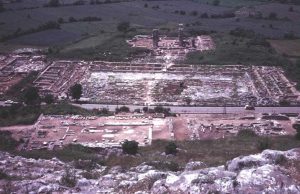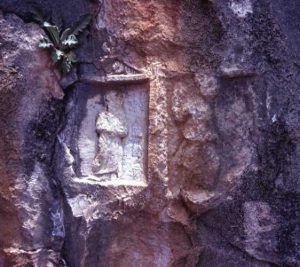As we have seen in other posts, the city of Philippi in northern Greece was significant in the growth of the so-called “Christ cult” in the first century. St. Paul wrote a letter to the Jesus followers at Philippi, which has come down to us in the New (Christian) Testament and is a major reason that we know about Philippi and that overall region. Paul was dead by about 65 of the Common Era (CE) – most likely martyred in Rome – and the Christ cult grew around the Roman Empire, expanding beyond Judaism (especially after the destruction of the Jerusalem temple in 70 CE) and gaining converts among worshippers of the traditional Greek and Roman deities.![]()
What must always be kept in mind with this scenario is that those Greek and Roman deities did not go away as Christianity developed as its own religion, apart from Judaism. Contrary to a fairly widespread narrative that Christianity grew by leaps and bounds before becoming the “state religion” under Emperor Constantine in the early fourth century, pagan cults survived, both with regard to their physical structures and their practices and influence among people.
An artifact from ancient Philippi – a monument base in the forum – is among many archaeological finds from the site which, in addition to Paul’s letters, sheds important light on several aspects of the context of early Christianity:
- The Emperor Cult in the late first century CE (several decades after Paul’s death);
- The role of several prominent women – priestesses – in the Emperor Cult at Philippi; and
- The presence of priestesses and the deified Livia simultaneously with the veneration of the male God and his son, Jesus the Christ.
The Monument Base and the Forum
Early in the professional excavations at Philippi, a monument base for seven large statues was discovered in the forum. The base was situated along the length of the road that borders the northern side in immediate proximity to a temple on the eastern side, a temple that was dedicated to the Empress Faustina the Younger (120-175 CE). The base of the monument is approximately 25 feet long and honors the deified Livia (58 BCE-29 CE), wife of Augustus (63 BCE-14 CE) and mother of Tiberius (42 BCE-37 CE).
The Emperor Claudius (10 BCE – 54 CE) introduced the cult of Livia throughout the Empire in 42 or 44 CE. Thus the archaeologists can date the monument to the second half of the first century under the reign of Emperor Domitian (51-96 CE) or slightly before. As archaeologist Chaido Koukouli-Chrysantaki points out, “As a Roman citizen, Paul must have strolled in the forum, where statues of Augustus and his family stood, together with monuments to the Julio-Claudian emperors” (“Colonia,” 16).
 The forum itself was most likely executed as a single plan over the original Greek agora and completed during or slightly after the reign of Emperor Marcus Aurelius (r. 161-80 CE), long after Paul’s death but during the time when Christianity was developing throughout the Empire.
The forum itself was most likely executed as a single plan over the original Greek agora and completed during or slightly after the reign of Emperor Marcus Aurelius (r. 161-80 CE), long after Paul’s death but during the time when Christianity was developing throughout the Empire.
If we closely examine the inscriptions on the first-century Livia monument, we find the names of at least four priestesses of Livia. One was Maecia C.F. Auruncina Calaviana, who paid for the monument; she is named on the monument twice, as both priestess and donor. Maecia and her sister, Julia Auruncina, were daughters of a man named Caius.
Also among the named priestesses are Julia Modia, daughter of someone whose name is not extant, and Octavia Polla, daughter of Publius. Another name is illegible but probably belonged to a fifth priestess.
According to archaeologists Sève and Weber, Maecia’s brother, [..l]turius C. f. Vol. Crispus, was honored on a statue base in the forum. While most of the female honorees remain completely unknown, the name Modius – possibly related to the priestess Julia Modia – is attested during the reign of Marcus Aurelius as a magistrate who had supervised the construction of the forum temples.
So, between the priestesses on the monument base honoring Livia and the later temple dedicated to Faustina the Younger, we can see that two renowned and powerful women from the imperial family were honored in a prominent place in Philippi’s public sphere over the space of a century and a half. The priestesses named in conjunction with Livia, further, provide insight and context for the cultural background of the developing church.
Women and Their Cultic Roles in the Graeco-Roman Era and Beyond
As was the case throughout the Mediterranean in the Hellenistic and early imperial eras, elite families erected honorific monuments and statues in city agoras, and women were included in the honors. The building of such honorific monuments was a long-standing tradition in the Greek East since at least Hellenistic times, undertaken for reasons including civic responsibility, “the preservation of status, political ambitions, and even ideological developments” (Bremen, “Limits,” 299). Statues of priestesses, benefactresses, and women magistrates were very plentiful in the Greek world.
 Women functioned as priestesses in the imperial cult, sometimes along with their husbands or other male relatives. Therefore, the Philippi monument falls within this line of tradition. The priestesses named on the monument who performed roles in the Emperor cult would have been part of the culture at the time of Paul’s letter to the Philippians, and priestesses to other deities, such as Diana/Artemis, would also have been present, active and prominent in the city.
Women functioned as priestesses in the imperial cult, sometimes along with their husbands or other male relatives. Therefore, the Philippi monument falls within this line of tradition. The priestesses named on the monument who performed roles in the Emperor cult would have been part of the culture at the time of Paul’s letter to the Philippians, and priestesses to other deities, such as Diana/Artemis, would also have been present, active and prominent in the city.
This backdrop meshes consistently with the role of women around St. Paul, as attested in his authentic letters. As we have argued previously on a number of occasions, and contrary to what the traditional church has promulgated for centuries (and is still promulgated by certain branches of Christianity), women served as leaders from the beginning.
Furthermore, the veneration of the Empress Faustina the Younger at Philippi about a century later is probably in a continuum from the veneration of Livia and shows several things about the Philippi context:
- Elite families, including women, erected buildings and monuments in the empresses’ honor. These activities served many purposes, including keeping the family names public, announcing the families’ largess, and providing a prominent focal point for cultic activities.
- People at all levels of society (except Jews) were compelled to honor the deified imperial couple. They also looked to them for help and favors as if they were divine and repaid them with honors and thank-offerings.
- It is possible that the Empresses Livia and Faustina the Younger were seen to have bestowed favors or benefactions on the people of Philippi.
- Elite women served as priestesses in the cults, with some if not all of the related responsibilities and authority that came with such roles. On the positive side, this means that women, while lacking autonomy, absolute control over their own funds, and political power, exerted some influence in the community. There is even some evidence for slave women accumulating a certain amount of wealth, becoming freed and using their funds for similar purposes. Slave women and freedwomen (and their male counterparts) were members of religious associations along with upper-strata women and men and thus participated in association activities, even if they did not function as leaders (Ascough, Macedonian Associations, 52-54).
Finally, as Christianity developed at Philippi into the early Byzantine era – when the influential fathers and other male leaders and intellectuals were forcefully restricting women’s roles in the church – women continued to have leadership roles, and female images – such as Mary the mother of Jesus – persisted in the social fabric. As we noted in the context of same-sex missionary pairs buried under church auspices at Philippi in the fourth and fifth centuries CE, a woman named Posidonia was named as a deacon, and Pancharia, buried with her, was a “very humble canoness.” Another woman, Agatha, was referred to as a deacon in a fifth-century inscription from Extra-Muros Basilica at Philippi; she was buried with her husband, John, a treasury official and linen-weaver. The roles of both deacon/deaconess and canon/canoness, while somewhat varied in the developing church, were leadership positions for both women and men.
Conclusion
The Livia monument at Philippi demonstrates in a very physical, material way the prominence of priestesses – mostly from elite families – in the Emperor Cult at Philippi shortly after the time of St. Paul. These women had control of their own resources, at least to some extent, and would have been well known, if not also revered and respected to some extent, by their fellow Philippians. Even if they had self-interested reasons for erecting a monument, its existence proves the continuing tradition of women in leadership or propagandistic positions from centuries earlier; in other words, Paul and his contemporaries lived and worked in an atmosphere in which women would have expected to play active roles in a new (or developing) religion, and the authentic writings of Paul show that women were active and respected members in his circle.
Resources
Abrahamsen, Valerie. “Priestesses and Other Female Cult Leaders at Philippi in the Early Christian Era” in Joseph A. Marchal, ed., The People beside Paul: The Philippian Assembly and History from Below, 25-62. Atlanta, GA: SBL Press, 2015.
Abrahamsen, Valerie A. Women and Worship at Philippi: Diana/Artemis and Other Cults in the Early Christian Era. Portland, ME: Astarte Shell Press, 1995.
Abrahamsen, Valerie. “Women at Philippi: The Pagan and Christian Evidence,” Journal of Feminist Studies in Religion 3 (Fall 1987) 17-30.
Ascough, Richard S. Paul’s Macedonian Associations: The Social Context of Philippians and 1 Thessalonians. Tübingen: Mohr Siebeck, 2003.
Barrett, Anthony A. Livia: First Lady of Imperial Rome. New Haven and London: Yale University Press, 2002.
Bremen, Riet van. The Limits of Participation: Women and civic life in the Greek East in the Hellenistic and Roman periods. Amsterdam: J.C. Gieben, Publishers, 1996.
Collart, Paul. “Inscriptions de Philippes,” Bulletin de Correspondance Héllénique 57 (1933): 360-62.
Connelly, Joan Breton. Portrait of a Priestess: Women and Ritual in Ancient Greece. Princeton and Oxford: Princeton University Press, 2007.
Koukouli-Chrysantaki, Chaido. “Colonia Iulia Augusta Philippensis” in eds., Charalambos Bakirtzis and Helmut Koester, Philippi at the Time of Paul and after His Death. Harrisburg, Penn.: Trinity Press International, 1998.
Pilhofer, Peter. Philippi: Band I: Die erste christliche Gemeinde Europas. Tübingen: J.C.B. Mohr (Paul Siebeck) 1995.
Sève, Michel and Patrick Weber. “Un monument honorifique au forum de Philippes,” Bulletin de Correspondance Héllénique 112 (1988): 467-79.
